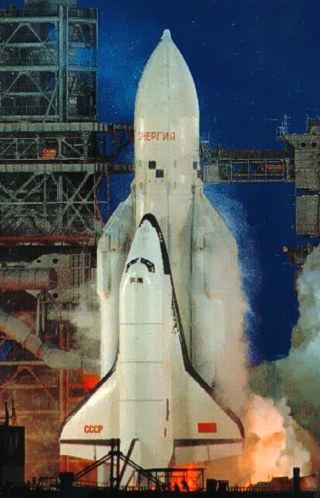- Buran (spacecraft)

caption =Buran on Launch Pad| country =Soviet Union
contract =
named_after = "Snowstorm"cite web | url = http://liftoff.msfc.nasa.gov/rsa/buran.html | title = Buran | publisher = NASA | date =12 November 1997 | accessdate = 2006-08-15]
first_flight =1K1
first_date =15 November 1988
last_flight =1K1
last_date =15 November 1988
missions =1
crews =0
time =3 hours
orbits =2
distance =
deployed =
dockings_mir =
dockings_iss =
status = Decommissioned,Buran #1 Collapsed due to poor quality.Buran #2 Destroyed in hanger collapse in 2002.Buran #3 On display at the Technikmuseum Speyer of Germany.|The Buran spacecraft ( _ru. "Буран, "Snowstorm" or "Blizzard"),
GRAU index "11F35 K1", was the only fully completed and operational space shuttle vehicle from the SovietBuran program . With a design that borrowed heavily from the AmericanSpace Shuttle , the Buran completed one unmanned spaceflight in 1988 before cancellation of the Soviet shuttle program in 1993. The Buran was subsequently destroyed by a hangar collapse in 2002.Like its American counterpart, the "Buran", when in transit from its landing sites back to the launch complex, was transported on the back of a large jet aeroplane. It was piggy-backed on the
Antonov An-225 Mriya aircraft, which was designed for this task and remains the largest aircraft in the world.Several shuttles were produced, one of those, the
OK-GLI was modified to fly with jet engines for aerodynamic testing. One painted mock shuttle (the former static test-articleOK-TVA ) is now a ride simulating space flight in Gorky Park,Moscow . The OK-GLI was sold by its owner NPO Energia, shipped to Sydney in Australia and subsequently displayed at the Sydney Olympics in 2000. Shortly after, the new owner went bankrupt and the OK-GLI shuttle then went toBahrain for a number of years while legal ownership status was in dispute. The Sydney/Bahrain (OK-GLI) shuttle was acquired by the GermanTechnikmuseum Speyer in 2004, [http://www.technik-museum.de/buran/] and has been transported to the museum, where it is exhibited to the general public.First flight
The first and only orbital launch of the (unmanned) shuttle "Buran" 1.01 occurred at 3:00 UTC on
15 November 1988 . It was lifted into orbit by the specially designedEnergia booster rocket. The life support system was partially installed and no software was installed to run the computer display screens.The shuttle orbited the Earth twice in 206 minutes of flight.cite book | first = Boris | last = Chertok | editor = Asif A. Siddiqi | title = Raketi i lyudi (trans. "Rockets and People") | publisher = NASA History Series | url = http://ntrs.nasa.gov/archive/nasa/casi.ntrs.nasa.gov/20050010181_2005010059.pdf | format = PDF | pages = 179 | year = 2005 | accessdate = 2006-07-03] On its return, it performed an automated landing on the shuttle runway at
Baikonur Cosmodrome , where despite a lateral wind speed of 17 metres/second it made a successful landing only 3 metres laterally and 10 metres longitudinally from the target.Video
Part of the launch was televised, but the actual lift-off was not shown. This led to some speculation that the mission may have been fabricated, and that the subsequent landing may not have been from orbit but from a shuttle-carrying aircraft, as with the Space Shuttle "Enterprise". Since then, the launch video has been released to the public, confirming that the shuttle did indeed lift off, with the poor weather conditions described by the Soviet media at the time easily seen.cite web | url = http://www.vunet.org/videos/story-170.html | title = Video: Soviet Shuttle Buran Launch | publisher = vunet.ru | accessdate = 2006-09-13]
Projected flights
Wikimedia Foundation. 2010.
